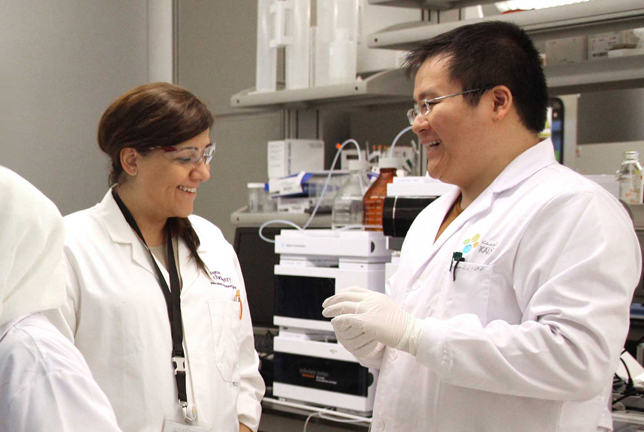KAUST Organic Chemistry Lab partners with industry to recycle an idea into recyclable plastics

Dr. Niveen Khashab with a few members from her lab.
"Some of the nanomaterials we prepared originally for biomedical applications turned out to be not really safe to be used so we decided to use these nanomaterials as fillers in plastics," said Dr. Niveen Khashab, Assistant Professor at KAUST.
Dr. Khashab makes it sound simple, but taking an idea designed for one application and transforming it into something useful in an entirely different industry isn't easy. And before her lab could even consider the idea, they had to find an industry partner who would be interested.
BLENDING RESEARCH WITH INDUSTRY
"What is really nice and what KAUST gives us is this mingling with industry and companies where we can see how our research could be applied," Dr. Khashab said. "I knew that SABIC (Saudi Basic Industries Corporation) was doing a lot of interesting novel material research, which made them a good partner." She went on to say that with this project, her team wanted to use commercially available materials and they also wanted to modify something that would potentially make it to the market.
"When you work in the academic field, you develop a lot of projects where you think it is innovative and interesting. But when you work with somebody who knows the market and knows processing, it gives you a brand new perspective that can help you out -- and help your design," she said.
She says working with industry is not like working with another academic. There are some limits on how much you are allowed to know due to company policies, but when it comes to creativity, working with SABIC pushed her creative boundaries. "When you work with industry, in terms of your materials of choice and your method of making the product, you need to take into account scalability. You need to think that this will be scaled-up and it needs to be cheap. It gives you a different perspective compared to what you normally would do for the sake of pure research," she said.
Dr. Khashab says meeting with industry and getting to know their needs helped steer the design and production process to make it better. "For me to find this link that my material can do this is interesting, especially being that I come from a biomedical background. To see things could be designed for one reason that could work very well for something else is how the interdisciplinary system works," she said.
Khashab is now hoping to establish more one-on-one projects with SABIC to keep on advancing the lab's work. "This project made me grow as a junior faculty. I learned things that I didn't know before. It was a learning experience," she said.

